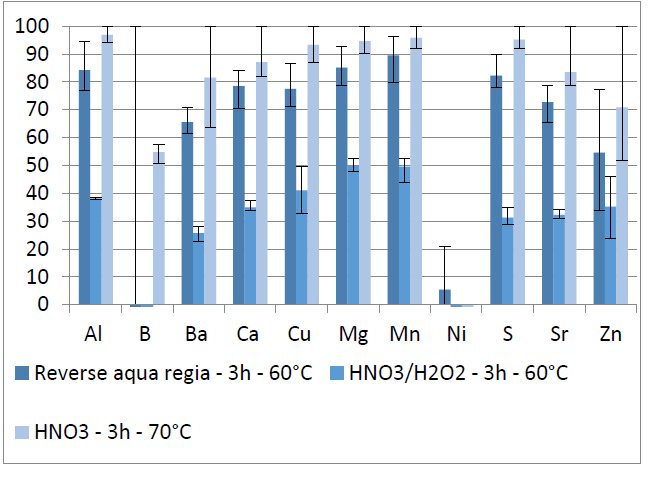|
Introduction
The objectives of the experiment are to analyse samples of tea and elaborate a representation to discriminate the different kind of tea as a function of their geographical origins. Camellia sinensis studies is important for nutritional and environmental stakes (nutritional and toxic elements). First, it is necessary to digest tea leaves and identify elemental fingerprint.< Br>
The analytical technique which was chosen, is ICP-OES (Inductively Coupled Plasma-Optical Emission Spectrometry), it enables to identify elements present in the sample rapidly and accurately.
Experimental conditions
Sample preparation: There were 3 parameters for optimisation: the acid employed for digestion, the heating temperature and the heating time.
4 acids or mixture of acids were tested for 40 mg of tea:
- 1 mL of nitric acid
- 1 mL of aqua regia (25% of nitric acid and 75% of hydrochloric acid)
- 1 mL of reverse aqua regia (25% of nitric acid and 75% of hydrochloric acid)
- 1 mL of nitric acid then 1 hour of heating 200 µL of hydrogen peroxide.
For the digestion, tea and acid were put in a vial of 2 mL and warmed in a hot water bath at 70°C or 60°C for 1, 3 or 5 hours. Then, samples are taken-off for a dilution in a volumetric flask of 50 mL to analysed with the ICP-OES.
Elementary measure – ICP-OES (Vista-Pro CCD-Varian-Agilent):
- Power: 1,20 kW
- Plasma flow: 15 L.min-1
- Nebulisation flow: 0,75 L.min-1
- Pump speed: 0,7 mL/min
- 5 repetitions measurement
Results
Figure 1 represents the intensity of elements in percent after the extraction of elements for the 3 top conditions: Reverse aqua regia at 60°C for 3 hours, HNO3/H2O2 at 60°C for 3 hours and HNO3 at 70°C for 3h. The results suggest the best conditions are 1 mL of nitric acid warmed for 3 hours at 70°C because this method gave a higher yield.
Finally, a diagram to classify the different types of tea is elaborated, the diagram shows intensity of the P 213,618 nm depend on the intensity of the Al 396,152 nm. On this graph, we can make out two types of tea: Chinese and French tea. Darjeeling (India tea) and Mongolian tea are out of these categories. Only the organic tea (a Chinese tea marketed in France) is not in either one circle or the other.
Conclusion
To conclude, this analytical method enables to classify tea according to theirs geographical origins, we don’t need a link between tea and theirs soil.
|
|

Figure 1: Percentage of intensity for the best three conditions for aluminium and calcium.

Figure 2: Diagram representing intensity P 213,618 nm in function of intensity Al 396,152 nm to separate 13 samples of tea with different geographical origins
|




